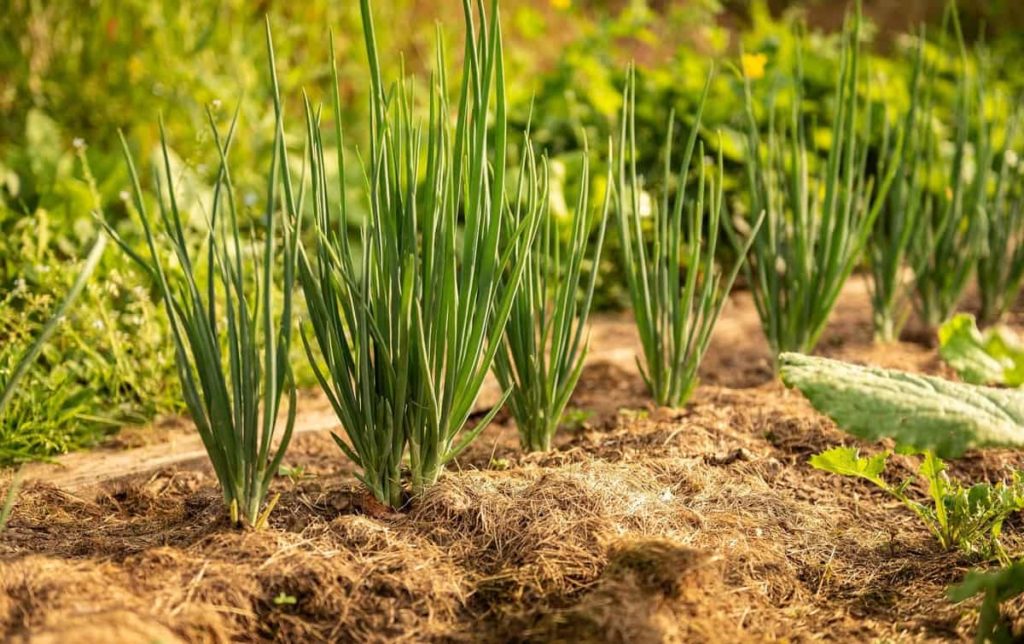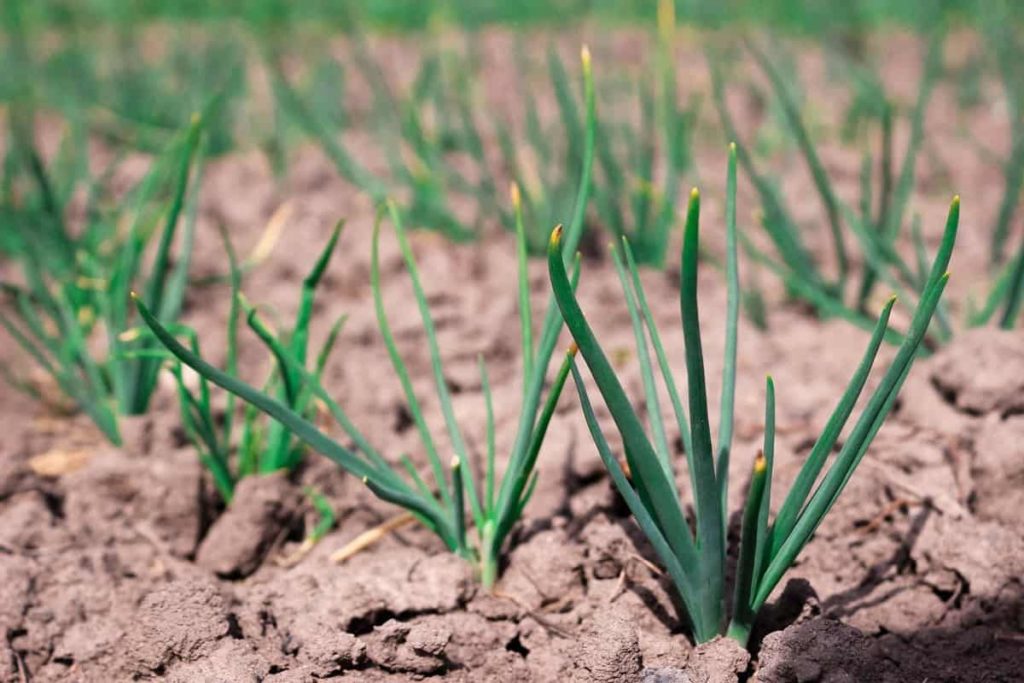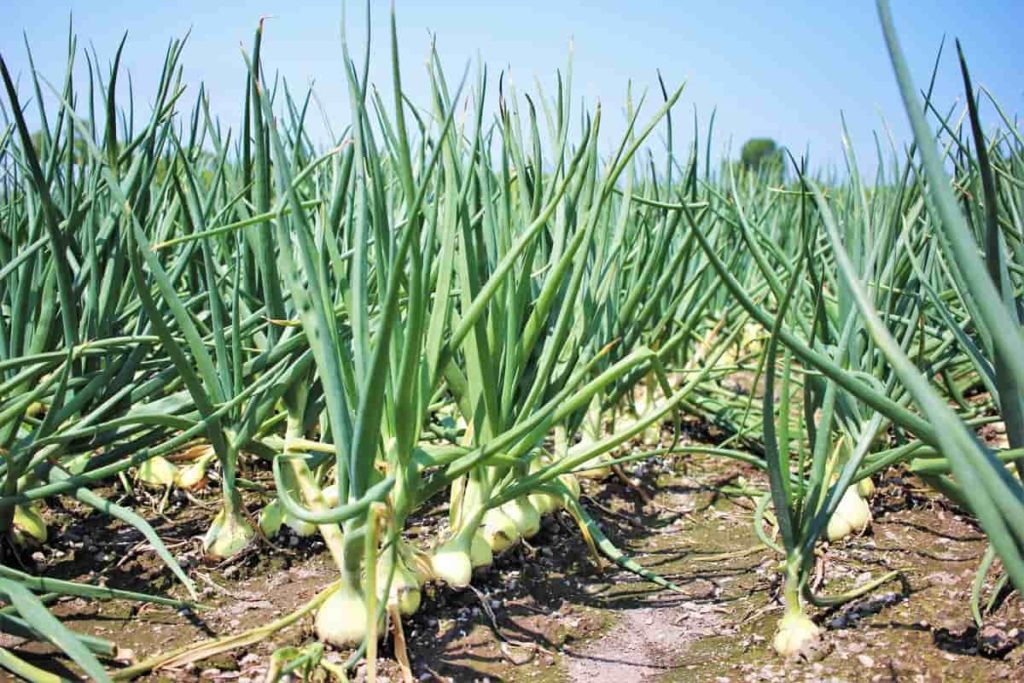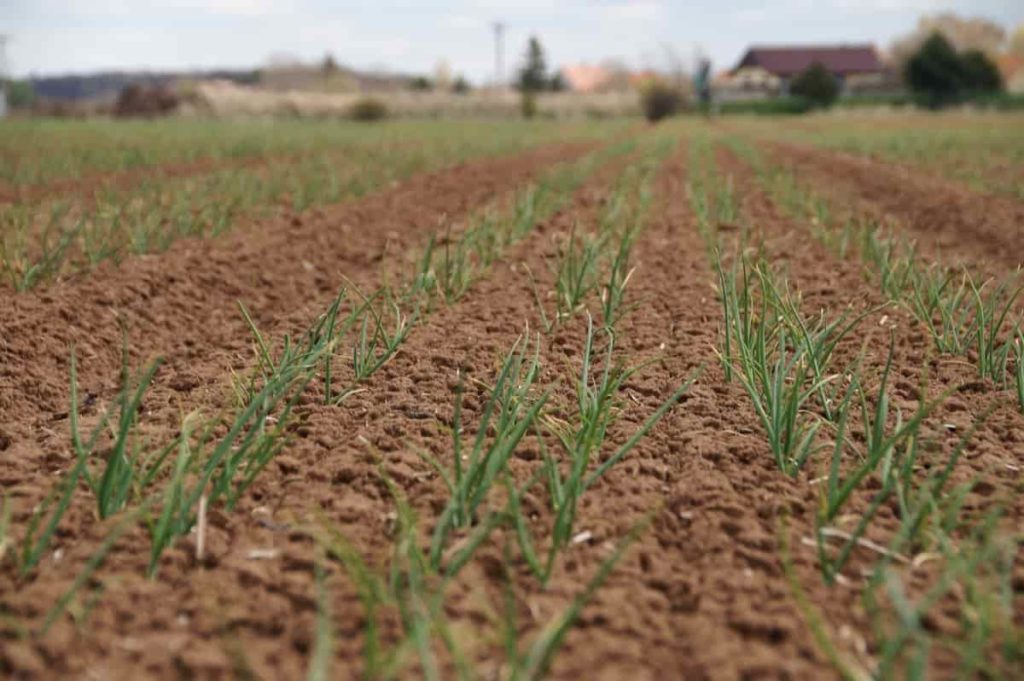Onions are a cold-weather crop and are easy to grow. Typically, they are planted in early spring and harvested in the fall. Whether you start with your Onion seed, set, or seedling, some trade tricks differentiate between a good and disappointing crop. Preparing soil before planting is a step that many gardeners skip, but the excellent growth of your Onions depends on perfectly fertile, well-drained soil.

Always check your soil before planting to determine whether it lacks any essential nutrients and minerals and determine soil pH. Almost all soils like heavy soil, clay soil, sandy, loam, etc., are suitable for Onion growing. However, soil with lots of organic matter and the ability to have good water should be viable. Therefore, it is more important to add organic matter during the preparation of land in the form of compost or farmyard manure, or well-rotted chicken manure.
Soil preparation for Onion plants
Soil pH for Onions
It’s also good to know if your soil is acid or alkaline before planting Onion sets and seedlings. The onion needs soil with a 6.0 to 8.0 pH range, and Onions cannot survive beyond limits. So get a soil sample a few months before the crop is set up to determine the needs of the lime and make the necessary lime applications in time.
If the soil test results show less than pH 6.0, apply dolomitic lime two to three months before the soil is prepared to bring the pH from a maximum range of 6.2 to 6.5. It is necessary to apply enough lime to keep the soil pH above 6.0. Low pH during the growing season can cause nutrient deficiency. Also, the high rate of fertilizer used in Onion production causes a decrease in pH during the growing season.
Nutrient deficiencies may occur during the year if the pH is not corrected at the beginning of the season, and production may decline. Although soil tests indicate a proper level, calcium and phosphorus deficiency can often be linked to low pH. But low pH can make it challenging to correct phosphorus deficiency during the growing season.
Soil types
Onions grow best in loamy, crumbly soil. Clay and slit are made up of tiny particles. Clay and slit hold moisture well but resist water infiltration, mainly when dry. Often puddles are formed on clay or slit soil, and they are easily compacted. The loam soil is loose and looks dark. The moist loam will form a ball when squeezed into your fist, which breaks when poked with the finger. The loam soil usually absorbs water and stores moisture well.
The loam soil can be based on sandy or soil, and moisture will vary accordingly in absorption and retention. Sandy soil contains large particles visible to the unaided eye and is usually light in color. The sand feels thick when wet or dry, and the ball won’t make it when it’s squeezed into your fist. The sandy soil remains loose and allows moisture to enter quickly but not retain it for long-term use.
In case you missed it: Onion Companion Plants, Onion Planting Guide

Preparation of soil for growing Onions in pots
Sandy loamy is the best type of soil to grow your Onions. It should contain a lot of organic material and not be heavier than soil or sand. To make sandy loam soil at home, add a generous amount of manure, peat moss, and sand to potting soil. Your container will do best with Onions in a pH of neutral, slightly acidic soil and will not mind even a medium growing a little alkaline.
Potting soil, rich in loamy and organic matter, is recommended to grow Onions in pots. Before you start planting, you can add 1/3 of compost or well-rotted manure to enrich the soil. Doing so minimizes the amount of care you give to your plants in increasing periods other than light and water.
Preparation of soil for growing Onions on grounds
Compost also adds essential nitrogen and other nutrients to the soil. You can also add dry manure at this time. Phosphorus is necessary for bulb formation, so select a balanced fertilizer or one that has more phosphorus than nitrogen. You can improve the soil in your planting bed and mix the compost, garden manure, or peat moss in the soil. You can also add two or more inches of organic material or coco-fiber potting medium and work it evenly in your soil.
Organic material binds sandy soil particles to maintain moisture and nutrients better. They also break down soil and slit particles so that water can penetrate and roots spread. Your lawn can also provide ideal organic material such as grass clippings (not treated with herbs) and chopped leaves. Grass and leaves provide soil nutrients, and they will also help loosen the soil. You can collect them, keeping in mind spring plantations in the fall.
In case you missed it: Onion Growing Tips, Tricks, and Secrets

How to grow Onions in poor soil
To make bulbs, the underground part of the Onion plant needs a lot of space in the loose soil. Plant Onions in heavy clay soil, or planting your Onions too closely makes it difficult for bulbs to grow. Modify your soil to loosen it before planting or plant your Onions in raised beds. There should be at least three to four inches of space between Onion plants to avoid crowding. Onions also need full sun.
Plants planted in a partial shade or full shade will not be able to produce the energy they need to divert energy into the formation of bulbs. To make Onion plant bulbs healthy enough, it needs enough nutrients in their early growth stages. Your Onion plants give a lush growth above the ground if there is too much nitrogen but will fail to produce bulbs. Choose balanced fertilizer and apply it a month after planting and then once more four weeks later.
For the plant to access nutrients in fertilizer, your Onion bed soil must have a pH between 6.2 and 6.8. High pH levels make it difficult for roots to take nutrients. For healthy growth and bulb formation, Onions require regular water.
Soil composting for Onions
Adding composted manure to the soil before planting increases the value of organic matter and nutrients to keep plants growing healthy. Manure lightens heavy soil, making it easier and less compacted to work with. The addition of organic matter enhances the moisture retention capabilities of sandy soil to keep it from drying fast during low rainfall. Compost improves soil quality every year; it is added due to organic material.
Prepare an Onion bed by turning it under animal manure or compost, making sure it breaks entirely before planting. Manure made from cedar or redwood is not an acceptable alternative to high-quality compost. Onions are heavy feeders, so add one cup of equal blood and bone meal portions to every 10 feet row.
In case you missed it: Growing Onions In Greenhouse – Planting From Seed, Bulbs, Sets

Land preparation for Onions
To get better tilth, it would be best to do the initial plowing to the maximum humidity limit. The number and depth of plowing depend on the size of the seed of the sown crop, and the root sample of the crop. Minimize the number of ploughings as far as possible to reduce the cost of cultivation as some crops may not require fully fine tilth. It is always beneficial to plow in summer and, therefore, wherever possible.
Summer plowing is very common if summer rains are received or too much irrigation water is available. Wait for 4 to 5 days after the initial plowing to reduce the moisture content of the clod and then get a better physical condition of the soil. When weed seeds only grow, you should repeat the operation. It is possible to plow the ground immediately after harvesting the previous crop.
You should add organic manure equivalent to 75 kg nitrogen per hectare at the last plowing and suitable size beds prepared after leveling. Mainly, flatbeds of size are formed 1.5 to 2.0 meters wide and 4 to 6 meters in length. However, flatbeds should be avoided to prevent waterlogging during Kharif or rainy season.
Waterlogging favors anthracnose disease, which is most devastating in Kharif season. To achieve proper distance and population density, 120 centimeters of upper width with 15 centimeters in height and 120 centimeters in upper width are formed. It is also suitable for drip and sprinkler irrigation.
Best soil mix for Onions
If you are starting Onions indoors, prepare a large container with potting soil and dig into slow-release fertilizer to help the roots get off to a good start. Wait for an Onion transplant until the soil temperature reaches about 15°C. The best soil to grow Onions is loose, loamy soil instead of heavy soil, so rotten manure is another good addition to the Onion bed.
Natural soil amendments for Onions
When planting Onions, loosen the soil to a depth of 12 inches and add 1 to 2 inches of compost. Bone meal is a natural soil modification that contains 10 to 13 percent phosphorus intake. Bone meal also contains some nitrogen. Bone meal works well for all kinds of bulbs, including Onions. Onions need some nitrogen, but not too much.
When the plants have leaves, you can dress Onion plants with 1 or 2 inches of compost, but do this when the leaves are green before they start dying back and make bulbs. Too much nitrogen in the weather can cause deformed bulbs too late. Phosphate is also available in rock phosphate and colloidal phosphate.
In case you missed it: Growing Small Onions In Pots – For Balcony, Terrace, Backyard

These soil amendments can be challenging to find and costly to use. In addition, the particles of the colloidal phosphorate are small and difficult to apply to the garden, so rock phosphate, also known as rock dust, is a better choice. Every three to five years, apply 4.5 to 4.7 kg of rock phosphate on 100 square feet of garden.
what to do with soil after growing Onions
After Onions, plant-heavy feeders like Tomatoes, Chillies, Winter Squash, Swedes, Winter Cabbage, Pumpkin, Radish, or lettuce. These plants’ roots create channels for water and air and bring them closer to the surface for shallow root plants. It prevents deficiency of nutrients in the soil as light feeders do not use many nutrients and replenish nutrients.
Reduces pests; if you constantly replant the same crop in one place, the pests that prefer this plant accumulate there, so moving the crop or planting something else breaks the breeding cycle and transfers their food source. Also, it reduces fungal diseases by replanting the same vegetable helps bacteria grow in soil and increases the risk of seeds causing root diseases.
Improves soil structure as you alternate between deep and shallow root crops since Onions are light feeders and shallow root plants, plant-heavy feeders, and deep-rooted vegetables after digging Onions.
- Tomato
- Beets
- Corn
- Cabbage family crops (such as Cabbage, Brussel Sprout, Broccoli, Radish, Cauliflower, and Kale)
- Celery
- Endive
- Cucumber
- Lettuce
- Pumpkin
- Squash
- Spinach
After crops from heavy feeders or deep-rooted plants, plant the soil makers like Peas and Beans, and then back to plant Onions and even Onions or other plants in the Amaryllis family. Legumes like beans and peas should not be applied after Onions. Some diseases come with growing Onions, and they affect the growth of beans. In addition, soil-related conditions will remain on broken roots in the ground and may affect peas and beans.
In case you missed it: Growing Organic Onions At Home – A Full Guide

Asparagus is another plant you should not grow after or with Onions. Also, do not plant Onions, Chives, Leeks, or Garlic to any other member of the Onion or Amaryllis family, such as after the Onion crop is produced. The plant’s families suffer from the same insects as well as diseases. Thus, planting vegetables from other families reduces the risk of pests and diseases.
- How to Grow Tomatoes Organically at Home: A Comprehensive Guide
- Organic Gardening on a Budget: Low-Cost Methods and Materials
- Gongura Seed Germination and Planting Methods
- Cabbage Seed Germination and Selection
- Broccoli Seed Germination and Selection
- Asparagus Seed Germination and Variety Selection
- Seasonal Flower Gardening: Best Practices for Spring, Summer, Fall, and Winter
- How to Grow Hibiscus from Flower
- Plantation Ideas for Home Decoration: A Beginners Guide
- Flower Garden Designs and Layouts for Beginners
- Planting and Spacing Techniques in Papaya: A Beginner’s Guide
- Growing Gold: Essential Techniques for Planting Pineapples
- How to Make Kalanchoe Plant Bushy: Home Remedies and Solutions
- 11 Reasons Why Your Gardenia is Not Blooming: Home Remedies and Solutions
- Eco Elegance: The Guide to Designing a Drought-Tolerant Landscape
- Gardening on a Slope: Strategies for Hillside Landscaping
- Nourish and Flourish: Top Organic Mulches for Thriving House Plants
- Everything You Want to Know about Indian Mogra Flower: Discover Uses and Growing
- Green Thumb Success: Expert Tips for Cultivating Greenhouse Pumpkins All Year Round
- Maximize Growth & Flavor: The Ultimate Guide to Companion Planting in Herb Gardens
- How to Control Rhododendron Problems Naturally: Home Remedies and Organic Ways to Fix Them
- Natural Magic: The Remarkable Benefits of Cinnamon for Plants
- Best Steps to Revive Dying Tulip with Natural and Organic Treatment
- 10 Reasons Why Your Angel Trumpet is Not Blooming: Remedies and Treatment
- How to Fix Periwinkle Leaf and Flower-Related Problems: Natural Remedies and Solutions
- How to Fix Zinnias Leaf and Flower Problems: Discover Natural and Home Remedies
- Organic Steps to Induce Lemon Tree Flowers: A Comprehensive Guide
- Bloom Booster: Crafting the Perfect Homemade Bougainvillea Fertilizer
- Optimizing Growth: A Guide to Applying NPK Fertilizer for Potted Plants
- 10 Best Homemade Fertilizers for Rubber Plant: DIY Recipes and Application Method
- How to Boost Female Pumpkin Flowers: Effective Steps for More Flowers and High Yields
- Transform Your Indoor Garden: Top Benefits of Pink Salt for Houseplants
- 10 Best Homemade Fertilizers for Peacock Plants (Calathea): Easy DIY Guide
- Unlock Blooms: 9 Reasons Why Your Potted Chrysanthemum is Not Blooming
- 8 Reasons Why Your Potted Hibiscus is Not Blooming: Fix it with Simple Solutions
- Unlock Blooms: 9 Key Reasons Your Potted Frangipani Won’t Flower